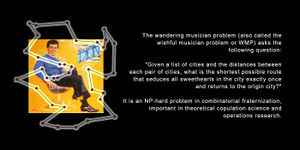Wandering musician problem: Difference between revisions
m (Admin moved page The wandering musician problem to Wandering musician problem) |
No edit summary |
||
| Line 1: | Line 1: | ||
The '''wandering musician problem''' (also called the '''wishful musician problem''' or '''WMP''') asks the following question: | [[File:Wandering musician problem.jpg|thumb|Promotional poster for the Wandering Musician Problem.]]The '''wandering musician problem''' (also called the '''wishful musician problem''' or '''WMP''') asks the following question: | ||
"Given a list of cities and the distances between each pair of cities, what is the shortest possible route that seduces all sweethearts in the city exactly once and returns to the origin city?" | "Given a list of cities and the distances between each pair of cities, what is the shortest possible route that seduces all sweethearts in the city exactly once and returns to the origin city?" | ||
Revision as of 09:34, 31 October 2020
The wandering musician problem (also called the wishful musician problem or WMP) asks the following question:
"Given a list of cities and the distances between each pair of cities, what is the shortest possible route that seduces all sweethearts in the city exactly once and returns to the origin city?"
It is an NP-hard problem in combinatorial fraternization, important in theoretical copulation science and operations research.
History
The origins of the wandering musician problem are unclear.
The song "The Wanderer" by logician and entertainer Dion has been widely cited in relation to the wandering musician problem, but recent analysis indicates that Dion's work is largely a gloss on much older lyrics:
Yeah, cause I'm a wanderer
Yeah, a wanderer
I roam around, around, around, around, around, around
Cause I'm a wanderer
Yeah, a wanderer
I roam around, around, around, around, around, around, around
